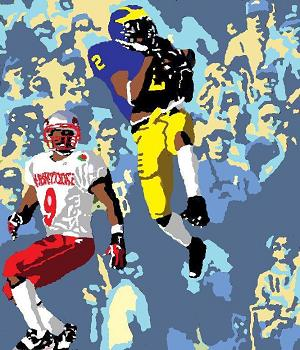1) Michigan 12-0
2) Nebraska 13-0
3) Florida State 11-1
4) Florida 10-2
5) UCLA 10-2
6) North Carolina 11-1
7) Tennessee 11-2
8) Kansas State 11-1
9) Washington State 10-2
10) Georgia 10-2
11) Auburn 10-3
12) Ohio State 10-3
13) Louisiana State 9-3
14) Arizona State 9-3
15) Purdue 9-3
16) Penn State 9-3
17) Colorado State 11-2
18) Washington 8-4
19) Southern Miss 9-3
20) Texas A&M 9-4
21) Syracuse 9-4
22) Mississippi 8-4
23) Missouri 7-5
24) Oklahoma State 8-4
25) Georgia Tech 7-5
For the second time thus far, we have a problem at the top of the poll. In 2003, it was the dubious selection of Southern Cal over BCS champion LSU. LSU played a much tougher schedule and, on the surface, appeared to have performed slightly better. However, deeper analysis showed that USC actually performed slightly better than LSU. For me, it wasn't enough to make up for LSU's vastly tougher schedule, but it was enough for me to compromise with the AP poll voters, and allow them to keep USC #1, albeit in a tie with LSU.
However, Michigan 1997 has an even weaker case than that of USC 2003. By the AP poll's own rankings, Nebraska (the coaches' poll #1) played 5 top 25 opponents to Michigan's 3, and 2 of those were rated higher than any team Michigan played. Nebraska outscored their opponents by an average of 30.2 points per game, Michigan by 17.3. And after the bowls, Nebraska had the #1 offense and #5 defense, while Michigan had the #45 offense and #2 defense.
And all of this was well displayed under the biggest magnifying lens: the bowl results. Playing highly comparable opponents, Michigan defeated PAC 10 champ Washington State (#9, 10-2) 21-16 in the Rose Bowl, while Nebraska defeated SEC champ Tennessee (#7, 11-2) 42-17 in the Orange Bowl.
So why was Michigan voted #1 at all?

Heisman winning cornerback Charles Woodson goes up high for an interception in the end zone to help Michigan secure a 21-16 victory over Washington State in the Rose Bowl.
